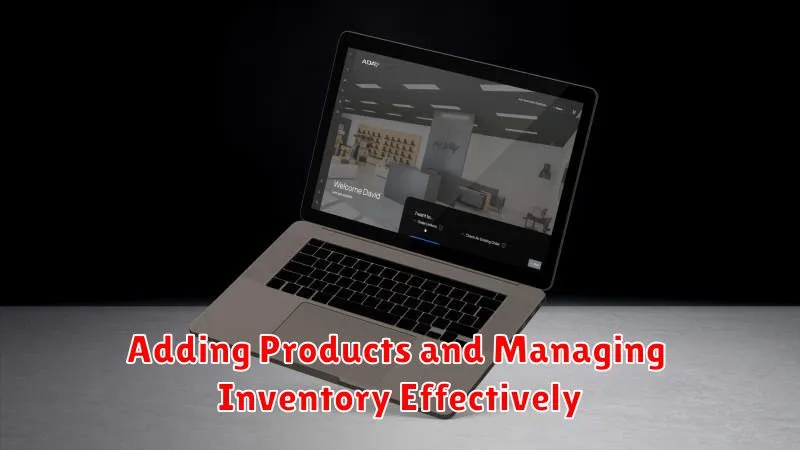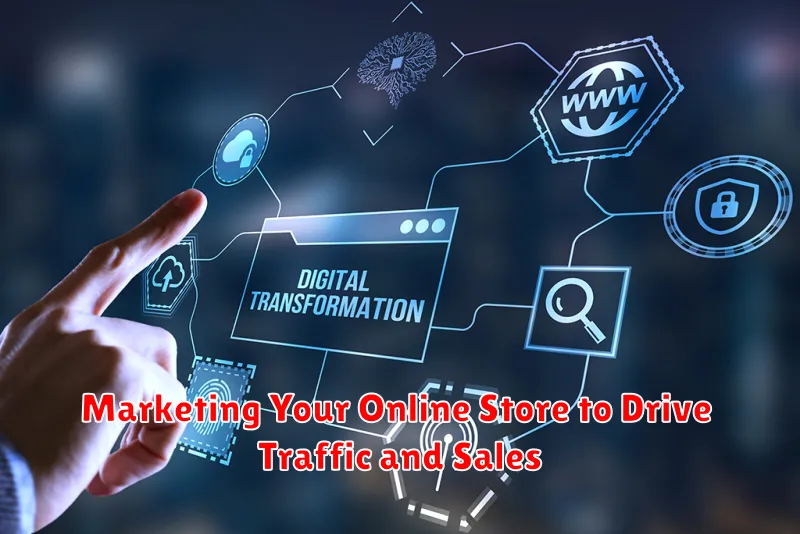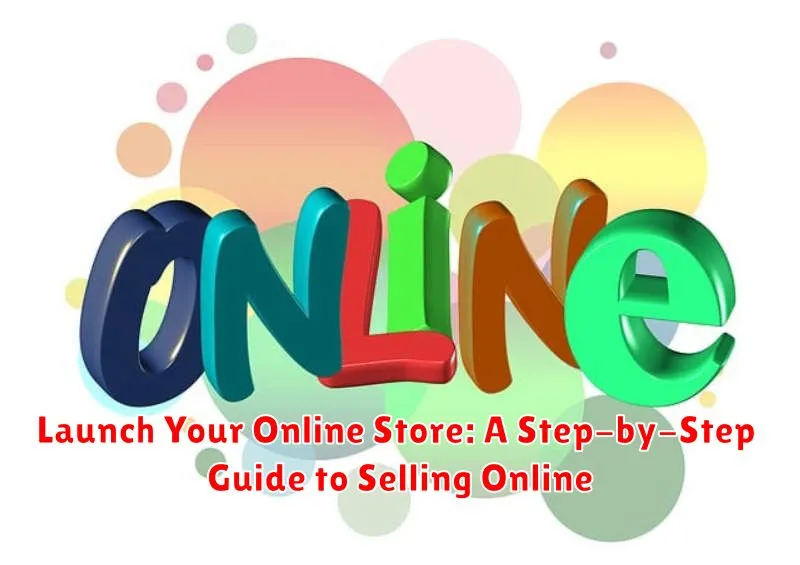Embarking on the journey of selling online can be an exciting yet daunting prospect. This comprehensive guide, “Launch Your Online Store: A Step-by-Step Guide to Selling Online,” provides aspiring entrepreneurs with a structured roadmap to navigate the complexities of creating and managing a thriving online store. Whether you’re looking to sell physical products, digital goods, or services, this guide will equip you with the knowledge and practical steps to successfully launch your online store and reach your target audience. From choosing the right platform and building your brand to marketing your products and managing orders, we’ll cover all the essential elements of selling online.
This step-by-step guide demystifies the process of establishing a successful online business. We’ll delve into the crucial aspects of e-commerce, including online store setup, product sourcing, online marketing strategies, and legal considerations. Whether you’re a complete novice or have some experience with selling online, this guide will provide invaluable insights and actionable advice to help you launch your online store and achieve your e-commerce goals. We’ll explore various online selling platforms, discuss effective online marketing techniques, and offer guidance on optimizing your online store for conversions. Prepare to transform your entrepreneurial dreams into a tangible online business reality.
Choosing the Right E-Commerce Platform for Your Needs
Selecting the right e-commerce platform is a critical first step in launching your online store. Different platforms cater to different needs, so careful consideration is essential.
Consider your budget. Some platforms offer free plans with limited features, while others charge monthly or transaction fees. Factor in these costs when making your decision.
Think about your technical skills. Some platforms are user-friendly and require minimal technical expertise, while others demand more advanced coding knowledge. Choose a platform that aligns with your capabilities.
Scalability is another important factor. If you anticipate significant growth, select a platform that can handle increasing traffic and sales volume.
Evaluate the platform’s features. Some platforms offer built-in marketing tools, while others integrate with third-party applications. Choose a platform that provides the functionality you need.
Finally, consider the level of support offered. Some platforms provide extensive documentation and customer support, while others offer limited assistance. Choose a platform that offers the support you require.
Setting Up Your Online Store: A Step-by-Step Guide
Once you’ve chosen your e-commerce platform, the next step is setting up your online store. This involves several key stages:
1. Choose a domain name. Your domain name is your online store’s address. Select a name that is memorable, easy to spell, and relevant to your brand.
2. Select a theme and customize it. Most platforms offer a variety of themes to choose from. Select one that aligns with your brand aesthetic and customize it to match your specific needs. This often includes adding your logo, choosing colors, and adjusting fonts.
3. Configure essential settings. This includes setting up shipping options, tax calculations, and notification preferences. Ensure these settings are accurate and reflect your business practices.
4. Organize your store’s navigation. Create a clear and intuitive navigation structure so customers can easily find what they’re looking for. This often involves categorizing your products and creating menus.
Creating a Compelling Brand Identity for Your Online Store
A strong brand identity is crucial for differentiating your online store in a competitive market. It’s more than just a logo; it encompasses your values, personality, and the overall experience you offer customers.
Start by defining your target audience. Understanding their needs, preferences, and pain points will guide your branding choices. Consider what makes your store unique. Do you offer specialized products, exceptional customer service, or sustainable practices? Highlight these unique selling propositions in your branding.
Develop a visual identity that reflects your brand personality. This includes your logo, color palette, typography, and overall aesthetic. Consistency is key across all platforms. Think about the message you want to convey through your visuals. Are you aiming for a modern, minimalist look, or a more rustic, handcrafted feel?
Finally, craft your brand voice. This is how you communicate with your customers through your website copy, social media posts, and email marketing. Your brand voice should be consistent with your visual identity and resonate with your target audience.
Adding Products and Managing Inventory Effectively

Effectively managing your product listings and inventory is crucial for a successful online store. This involves carefully adding product details, organizing your inventory, and tracking stock levels to avoid overselling or stockouts.
Adding Product Details
When adding products, provide comprehensive information. This includes high-quality images, detailed descriptions, variations (like size and color), and unique product identifiers (SKUs). Accurate product data helps customers make informed decisions and reduces returns.
Inventory Management Techniques
Use a robust inventory management system. Track your stock levels in real-time to ensure accurate availability information on your website. Set up low stock alerts to avoid selling items you don’t have. Consider using inventory management software or integrating with your e-commerce platform’s built-in tools.
Inventory Organization
Organize your inventory physically and digitally. Categorize products logically to simplify searching and filtering. A well-organized system also makes fulfilling orders and conducting inventory checks easier.
Setting Up Payment Gateways and Processing Transactions
Accepting payments is crucial for any online store. Payment gateways act as intermediaries, securely processing transactions between your customers and your bank account. Choosing the right gateway depends on factors like transaction fees, supported currencies, and integration with your e-commerce platform.
Popular options include PayPal, Stripe, and Square. Each offers different features and pricing structures, so carefully compare them to find the best fit. Consider transaction volume, average order value, and any specific needs your business may have.
Setting up a payment gateway typically involves creating an account with the provider, linking it to your online store, and configuring settings such as accepted payment methods (credit cards, debit cards, etc.). Ensure you understand the fees involved, including transaction fees, monthly fees, and chargeback fees.
Once integrated, test the payment process thoroughly to ensure a smooth checkout experience for your customers. This includes testing different payment methods and amounts to verify transactions are processed correctly and funds are deposited into your account.
Marketing Your Online Store to Drive Traffic and Sales

Driving traffic and sales is crucial for any online store’s success. A multi-faceted marketing strategy is key.
Search Engine Optimization (SEO) is essential for organic visibility. Optimize your website’s content and structure with relevant keywords to rank higher in search engine results.
Leverage the power of social media marketing. Engage with your target audience on platforms like Instagram, Facebook, and Pinterest to build brand awareness and drive traffic to your store. Consider running targeted ad campaigns to reach a wider audience.
Email marketing is another effective tool. Build an email list and send out regular newsletters, promotions, and product updates to keep your customers engaged and informed.
Consider paid advertising options like Google Ads or social media ads to quickly reach potential customers and boost your sales. Carefully manage your budget and track your ad campaign performance.
Providing Excellent Customer Service and Building Loyalty
Customer service is paramount to the success of any online store. Positive experiences foster loyalty and encourage repeat business. Responding promptly and efficiently to customer inquiries is crucial.
Offer multiple communication channels, such as email, live chat, and phone support. Ensure your team is knowledgeable about your products and policies. Empower them to resolve issues quickly and effectively.
Building loyalty involves more than just resolving problems. Consider implementing a loyalty program to reward repeat customers. Offer exclusive discounts, early access to sales, or free shipping. Personalized communication, such as birthday emails or product recommendations, also strengthens customer relationships.
Collecting customer feedback through surveys or reviews helps identify areas for improvement. Actively addressing concerns demonstrates a commitment to customer satisfaction and builds trust.
Managing Shipping and Fulfillment for a Seamless Experience
Efficient shipping and fulfillment are crucial for customer satisfaction and repeat business. Streamlining these processes can significantly impact your online store’s success. Choose the right strategy for your business model and resources.
Shipping Options
Offer a variety of shipping options to cater to different customer needs and budgets. This might include standard, expedited, and even free shipping above a certain purchase amount.
Fulfillment Methods
Consider different fulfillment methods: in-house fulfillment, where you handle storage and shipping yourself; or outsourcing to a third-party logistics provider (3PL). Each option has its own advantages and disadvantages related to cost, control, and scalability.
Packaging and Handling
Secure packaging protects your products during transit and prevents damage. Consider branding opportunities with custom packaging to enhance the customer experience.
Order Tracking and Communication
Provide customers with real-time order tracking information and proactive communication regarding their shipments. This transparency builds trust and reduces anxiety about delivery times.

